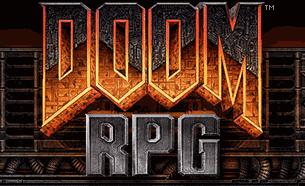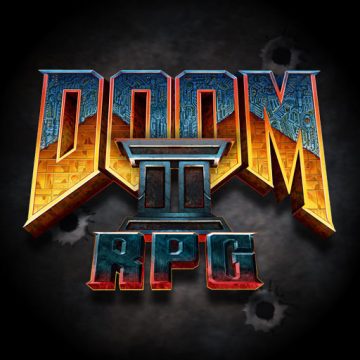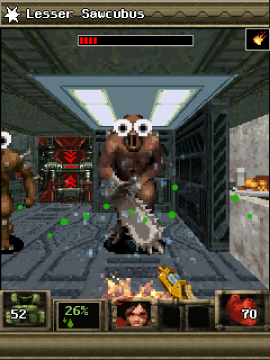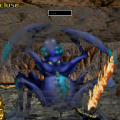

If you’ve read our pieces over the Orcs & Elves games and Wolfenstein RPG, you should already be well met with Carmack’s strange foray into mobile development. He and his wife, Katherine Anna Kang, ended up making a new engine and making little phone games with it (alongside a small team), Orcs & Elves getting spots two and three, and Wolfenstein RPG getting the forth spot. The bread in this quirky sandwich ended up being both Doom RPG and Doom II RPG, released in 2005 and 2009 respectfully, with the latter getting an iOS release the following year. The idea was to break into a new growing market, and seeing the limitations of the hardware, Carmack settled with turn based dungeon crawling.

The amount of bizarre and slightly cursed photos of John Carmack is staggering
If you try to fit these into the Doom timeline, you will go mad, just accept them as their own continuity. They both present the demon invasions as complete unknowns to the characters, especially in the second game, which also hints that the two doomguys are brothers instead of the same character as both games may be happening in parallel. You kind of have to go with that since the second one is named Stan Blazkowicz, and the other is named B.J Blazkowicz, probably because Carmack doesn’t think too hard on narrative cohesion or original creative concepts. It’s a neat idea that Wolfenstein and Doom have the same continuity and is made explicitly canon here.
Doom RPG (Mobile)
Doom RPG (Mobile)
Each has a similar set up, though. The first game revolves around a scientist mucking up a UAC research base and you having to look into it, and the other is similar but mixes it up with a mysterious evil AI and dimension hopping. You play as B.J the who knows at this point in the first one, while you can pick from Stan, his major Kira (based on Quake III‘s Major), and a civilian scientist named Riley in the second. Your choice decides mainly your starting stats, Stan able to tank and make good use of a chainsaw, Kira accurate and able to dodge better, and Riley having high starting I.Q that makes minigames a bit easier, while having lower stats overall. You can’t go wrong with any decision, as you’ll have the chance to boost the stat of any character to make up for their weak spots a bit.
It’s interesting comparing these two because we get to see these games at their most primitive and most polished. The original is mainly sprite rips from the older Doom games with a lot of pallet saps, using a more simplified mapping layout seemingly based off of Wolfenstein 3D‘s simplistic, horizontal mazes. The few new sprites are mostly static, outside weird additions like a fire ax and the dog weapon (self explanatory), meaning the context Carmack and team made for what’s happening has to help carry the weight alongside the basic gameplay loop.
Doom RPG (Mobile)
Doom RPG (Mobile)
It’s an admirable first attempt, especially for a Java game. It’s limited in sound, as to be expected from early mobile games, but familiar Doom effects and music stings do a lot to make this feel authentic. The abuse of sprite recolors is also somewhat forgivable just for the base variety they had to work with from just the classic game demon set. We even get the archvile in here, unfortunately. Monster reviving jerk is a much bigger problem in a turn based game with cramped rooms. Where it starts to trip up is the pacing, which is drawn out and needlessly repetitive.
Like any Doom game, there are secrets to find, mostly as wall secrets, but you can’t get everything in a level first go. No, you’ll collect items as you progress, including key cards, that can be used in previous levels via a hub base to find extra goodies. If you are a completionist, this might be a bit obnoxious, made worse by it breaking apart the difficulty. See, you level up as you would any RPG from doing things like demon murder, and when you go back to a level, everything resets – including both your map of it and the demons that lie there. You have to fight everything again, which means you’ll get more experience that may level you up faster than initially intended, and while that could be fun, fights are often too sluggish to be fun in and of themselves.
Doom RPG (Mobile)
Doom RPG (Mobile)
Level three and on really starts to take the piss, especially with the heavy focus on a weapon weakness system, every monster having different weapons they’re weak to. So, you’ll constantly be scrolling for the proper weapon, which just adds more time to the whole process. Also, I hope you like password puzzles, because you’ll be seeing a lot of them, and they waste so much time. The game drags way too much to try and create replay value, heads above most of what was around at the time but poorly aged compared to Fountainhead’s later efforts. It’s a cute idea, but that idea needed to be fleshed out further, which did happen with each new game from Carmack’s new little studio.
By Orcs & Elves, the studio realized it’s probably best to limit the amount of experience the player can get for a better difficulty curve, and Doom II RPG makes the most use of those lessons. There’s still some limitations in the Java version, like the weapon scrolling is still slow, but a lot of smart decisions have also been made. For one, you’re limited in encounters and bonus experience, and there are eventual caps on stat boosting. You can do little minigames to boost every stat, minus strength which just requires you to find the chainsaw and then find some meat (to chainsaw), but they’re purposefully repetitive so you don’t feel like grinding them out. They’re also encountered at only a few places and have their own caps as well.
Doom II RPG (Mobile)
Doom II RPG (Mobile)
Mobs can be much tougher, which is why you need to use money not for stat boosts and ammo this time, but for drinks that give temporary buffs, like fire resistance, hard stat increases, and health regeneration. You’ll get a lot of these, and they help decide how tough a fight is gonna be depending on how well you use them. You can use them in battle, but it uses up turns, though the game is nice enough to let you use both a flak jacket and health pack for healing and armor regain in one turn. Still expect to feel the pain, especially the many moments in the second half where you’ll often encounter large numbers cornering you in a scripted event.
Weapons are also a bit different, as you figure out quickly upon getting the holy water gun, replacing the fire extinguisher and having the added effect of making most demons enter a panic state as they move away from you for a few turns. Your starting rifle gets a scope that you can use to snipe enemies for big damage and little ammo cost (though there is a timer on it before the game says your turn is used), and you can even use little robot buddies to recon an area and take care of demon threats to no risk of you. A lot of the expected are back, including the BFG towards the end game, and you even get Doom 3‘s soul cube with the same mechanics.
Doom II RPG (Mobile)
Doom II RPG (Mobile)
The game’s technical performance also can’t be overstated. Even on the Java release and not the superior iOS version, Doom II RPG looks night and day to the original, complete with animated sprites, full cutscenes, reflection tech, polygonal models, more detailed and colorful menus and HUD objects, and even returning gibbing. It is the AAA release equivalent for a mobile phone release before the smartphone became all the rage, a true technological marvel matched with a delightful tone.
It’s clear Carmack views games more as toys than anything else, and his wife seems to have a similar mindset, but has more of a creative bent then he does. Doom II RPG has some really fun, witty writing alongside purposefully ridiculous bits, like the worker who just learned about moonwalking, or the ability to loot enemies and often find useless junk like a pocket quran or a human finger. The Doom references are thick, obvious, and kind of funny in how blatantly they’re shoved in. This game is basically the final form of dad jokes, but still manages to have an engaging plot due to how unlike Doom the main premise is. Leaves you guessing for a bit, though where it’s headed does start to become a bit obvious after a while.
Doom II RPG (Mobile)
Doom II RPG (Mobile)
It’s also nice to have so many things to do. While the first game was limited to putting out fires or talking to NPCs in a certain order, the sequel has you hacking vending machines for discounts, sending in a robot into a gas filled room to get a super shotgun (shockingly underpowered in this game), exercising on a treadmill, using a cafeteria conveyor system to find a key card, and so much more. There are unique encounter events as well, giving the game more of a Doom feel even with the silly tone compared to the first just having dudes hanging around during a demon invasion. You can also pick up toilets and throw them, as a treat. Even the boss fights are great, with unique challenges and conditions. The spider mastermind sticks out for having to have a tricky sniping war in the first part.
The iOS version has an additional comic book that just confuses the continuity even more by mentioning Mars, but otherwise benefits from better graphics and sound overall. You can’t go wrong with either version. If you’ve enjoyed any of the previous Fountainhead RPGs, this one is a must. The original is also a neat novelty and easily accessed from the internet archive. Worth mentioning that the first game ended up being a sequel to Wolfenstein RPG, which has a direct reference to that game’s ending. Neat little touch.
Doom II RPG (iOS)
Doom II RPG (iOS)
Doom II RPG also came out the year that Id Software was bought by ZeniMax, and by extension, Bethesda. Carmack has some clearly bad blood with this he’s been pretty vocal about, so the end of these little RPGs probably has their stink about it, as did probably the frustrations with getting RAGE done and trying to make a new Quake set in the original continuity before Carmack huffed off to do work in VR. He’d be gone by 2013, and a lot was happening in the company at the time, including the development of one game you’ll never get the chance to play. There was a team at Id making the next game in the Doom franchise, and boy, did a lot happen during that process.


